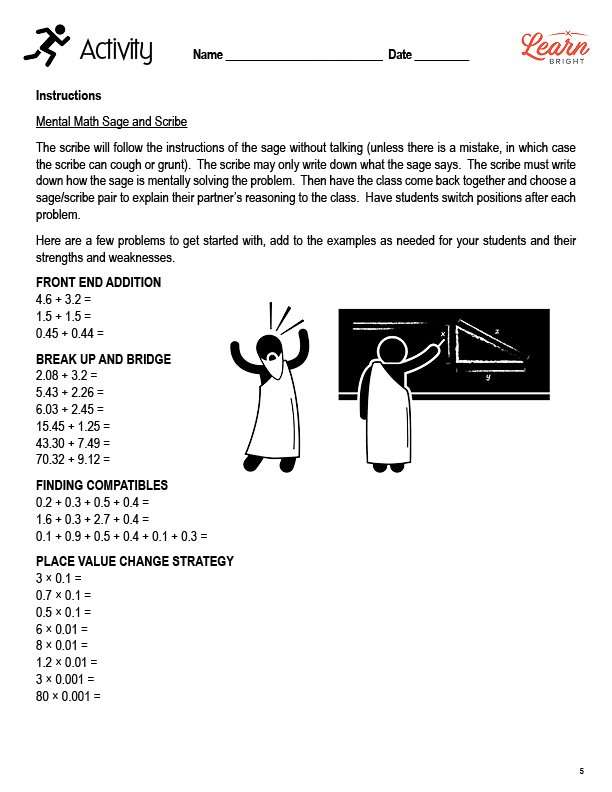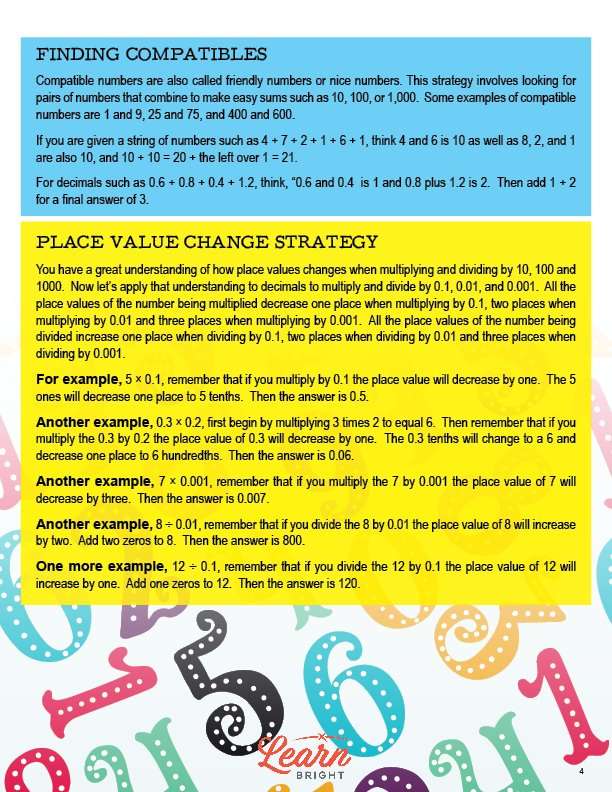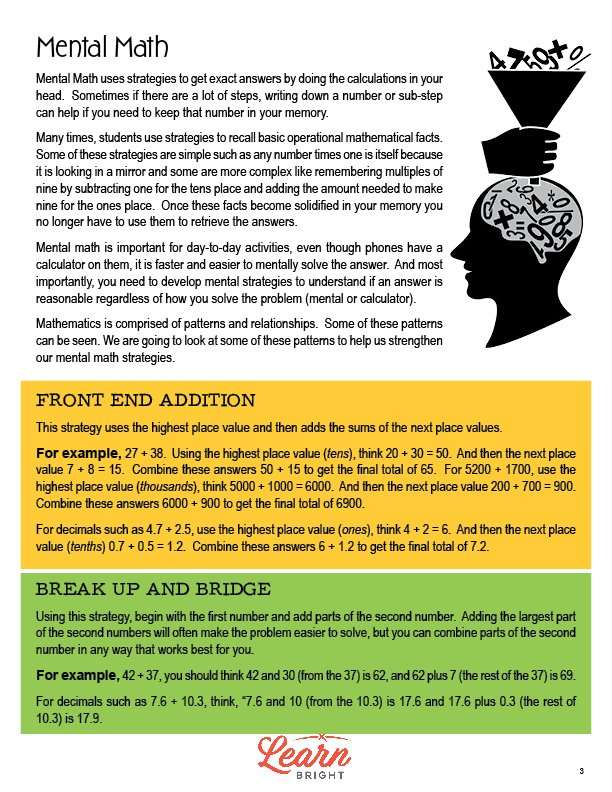Description
What our Mental Math lesson plan includes
Lesson Objectives and Overview: Mental Math introduces various strategies to guide students through the process of solving math calculations and performing math reasoning in their mind. The strategies presented are reinforced with opportunities for students to develop confidence in their accuracy by practicing problems with and without using mental math strategies, as well as a group discussion on how they used a particular strategy. At the end of the lesson, students will be able to compute mathematical problems in their head using various strategies. This lesson is for students in 4th grade, 5th grade, and 6th grade.
Classroom Procedure
Every lesson plan provides you with a classroom procedure page that outlines a step-by-step guide to follow. You do not have to follow the guide exactly. The guide helps you organize the lesson and details when to hand out worksheets. It also lists information in the blue box that you might find useful. You will find the lesson objectives, state standards, and number of class sessions the lesson should take to complete in this area. In addition, it describes the supplies you will need as well as what and how you need to prepare beforehand.
Options for Lesson
Included with this lesson is an “Options for Lesson” section that lists a number of suggestions for activities to add to the lesson or substitutions for the ones already in the lesson. One optional addition to this lesson is to have your students break into groups and choose a strategy to make a poster about and to teach the class. You can also have your students use cards to play mental math games using the first card as the ones and the second card as the tenths to create problems. Finally, you could have students discuss why mental math will be important to them in higher level math classes.
Teacher Notes
The teacher notes page includes lines that you can use to add your own notes as you’re preparing for this lesson.
MENTAL MATH LESSON PLAN CONTENT PAGES
Mental Math
The Mental Math lesson plan includes two content pages. When we use mental math, we get exact answers by doing calculations in our heads. If you’re solving a problem with a lot of steps, you might need to write down a number or sub-step to keep them in your memory.
Students often use mental math strategies to recall basic operational mathematical facts, like that any number times one is itself. Once they practice using these facts enough, they won’t even need to think about them to solve problems.
We use mental math every day, even when we don’t realize it. Even though your phone has a calculator, it is often easier and faster to solve simple math problems using mental math. This also helps develop mental strategies to determine if an answer is reasonable, whether you used mental math or a calculator to find that answer.
Mathematics is full of patterns and relationships. We can learn some of these patterns to make solving math problems easier and strengthen our mental math strategies. The lesson describes a few of these strategies and includes examples of each.
Front End Addition
With this strategy, we use the highest place value and add the sums of the next place values. For example, say we want to solve the equation 27 + 38. We use the highest place value (tens) and add them using mental math: 20 + 30 = 50. Then, we move on to the next place value (ones): 7 + 8 = 15. We then add those together to get our final answer: 50 + 15 = 65, so 27 + 38 = 65.
We can also use this strategy to solve addition problems with even larger place values or decimals!
Break Up and Bridge
For this strategy, we start with the first number and add parts of the second number. We often add the largest part of the second number first, but you can add any part of the second number if that makes more sense to you.
For example, for the problem 42 + 37, we might first add 42 and 30 (the largest part of the number 37) to get 62. Then, we add 62 + 7 (the rest of the number 37) to get a final sum of 69.
Finding Compatibles
To use this strategy, we find compatible numbers, also called friendly or nice numbers. We look for pairs of numbers that we can combine easily to form easy sums like 10, 100, or 1,000. 1 and 9 are compatible numbers, for example, because they add up to 10.
For example, say we are given a string of numbers such as 4 + 7 + 2 + 1 + 6 + 1. First, we want to find compatible numbers. In this list, 4 and 6 equals 10 as well as 7, 2, and 1 are also 10. 10 + 10 = 20 + the left over 1 = 21.
Place Value Change Strategy
We can apply our understanding of how place values changes when multiplying and dividing by 10, 100 and 1000 to decimals to multiply and divide by 0.1, 0.01, and 0.001.
When multiplying by 0.1, all the place values of the number being multiplied decrease one place. When multiplying by 0.01, they decrease by two place. And when multiplying by 0.001, they decrease by three places.
When dividing by 0.1, all the place values of the number being divided increase one place. When dividing by 0.01, they decrease by two places. And when dividing by 0.001, they decrease by three places.
For example, let’s take a look at the problem 5 × 0.1. If you multiply by 0.1 the place value will decrease by one, which means that the 5 ones will decrease one place to 5 tenths. Therefore, our answer is 0.5.
Let’s look at the division problem 8 ÷ 0.01. If you divide the 8 by 0.01, the place value of 8 will increase by two. We add two zeros to 8 for an answer of 800.
The lesson closes with a few more examples using both multiplication and division.
MENTAL MATH LESSON PLAN WORKSHEETS
The Mental Math lesson plan includes four worksheets: an activity worksheet, a practice worksheet, a homework assignment, and a quiz. You can refer to the guide on the classroom procedure page to determine when to hand out each worksheet.
SAGE AND SCRIBE ACTIVITY WORKSHEET
Students will work with a partner to complete the activity worksheet. In each pair, one student will be the sage and the other will be the scribe. The scribe will follow the instructions of the sage without talking (unless there is a mistake, in which case the scribe can cough or grunt). The scribe may only write down what the sage says. The scribe must write down how the sage is mentally solving the problem.
The class will then come back together and choose a sage/scribe pair to explain their partner’s reasoning to the class. After each problem, students will switch positions.
STRATEGIES PRACTICE WORKSHEET
For the practice worksheet, students will use four different strategies (front end addition, break up and bridge, finding compatibles, and place value change strategy) to solve problems.
MENTAL MATH HOMEWORK ASSIGNMENT
The homework assignment asks students to solve problems using a mental math strategy of their choice.
QUIZ
This lesson also includes a quiz that you can use to test students’ understanding of the lesson material. For the quiz, students will use different mental math strategies (front end addition, break up and bridge, finding compatibles, and place value change strategy) to solve each problem. They should make sure to show their “mental” work.
Worksheet Answer Keys
This lesson plan includes answer keys for the practice worksheet, the homework assignment, and the quiz. If you choose to administer the lesson pages to your students via PDF, you will need to save a new file that omits these pages. Otherwise, you can simply print out the applicable pages and keep these as reference for yourself when grading assignments.









